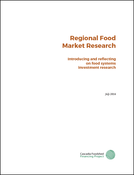|
Tim Crosby, Project Coordinator
The Cascadia Foodshed Financing Project (CFFP) is please to share it's innovative research with other investors, government agencies and interested enterprises. The research includes a production cost analysis by Ecotrust of six food categories to show where investors can help catalyze a strong, thriving food economy in the Pacific Northwest. It also includes an independent lender analysis of Ecotrust’s work, focusing on near-term enterprise investments suggested by the research. Both efforts are part of CFFP’s multi-year effort to understand how and where to invest philanthropic, impact, and financial capital into sustainable food enterprises located in the Pacific Northwest. For this research we define Pacific Northwest as Washington and Oregon. Other activities in the food system and impact investing sectors compliment CFFP’s research and suggest directions for next steps. The Toniic Institute recently released “ Venture Philanthropists & Impact Investors: sharing collaboration successes and challenges.” This report defines complimentary interests between venture grantmakers and impact investors. It suggests that philanthropists play an important role when they are willing to take high risk positions in food system loans, using structures that are a hybrid of the loan and the grant. A workshop at the Sustainable Agriculture and Food Systems Funders recent annual forum entitled Bridging the Finance Gap illuminated the same role and similar opportunities. Origin of this research CFFP operates at the intersection of food, finance, and philanthropy. We attempt to align community, private, and corporate foundations with private and government capital interests. We work with creative tension rising from the uncertainty of what will propel good food systems forward, and the question of what kind of money is needed to make it happen. This healthy tension has driven CFFP partners forward in our efforts to seek clarity of need, common ground among players, and viable investment opportunities. The tension between the unknowns in healthy food systems and the search for appropriate financial support exists throughout the food impact investing space. Questions abound regarding different logic models, different investment criteria, different investment tools (i.e. grants, loans, guarantees, equity), and different definitions of returns (i.e. system change, growth, capital preservation, profit). In fact one of CFFP’s early actions was to create a basic vocabulary we use in our collaborative work as it became clear that we need to better understand and align the interests of engaged actors. In 2014 CFFP launched our first attempt in collaborative investing (CFFP1). We had three main goals for this round: identify the types of enterprises seeking different forms of investments; determine how we could collaboratively invest; and finance aligned enterprises. We learned that the majority of visible enterprises seeking financing were startups; that the foundation investment departments were risk-averse to startups and direct investments; and that we did not have the internal expertise to provide appropriate due diligence. While a few enterprises did receive financing from this round, we realized we needed to be more strategic about what we wanted to finance, and to determine if an intermediary was needed. CFFP took the learnings from CFFP1 and pivoted efforts to four priority steps:
The first step- develop a more defined strategy - produced a Theory of Action that places wellness and economic viability as the primary goal of CFFP’s food system investing work, with three proof points of success:
The second step - commission research – began just as Ecotrust was finalizing the Oregon Food Infrastructure Gap Analysis, a 15-month study funded by Meyer Memorial Trust (MMT), a CFFP partner. That report provided solid evidence that the mid-scale producers, “Ag of the Middle”, need key infrastructure to compete. Sayer Jones, MMT’s Director of Finance and Mission Related Investing, mentioned how a farmer advisor to that project said “This research is very compelling, but I just want to know why my product is more expensive when it hits the loading dock.” From this question emerged a quick case study examining the production costs of pastured chicken. CFFP’s Market Research built on that case study. We felt that, due to regional similarities, the Oregon infrastructure report was relevant to Washington, and that further research on sustainable food products viable in Washington would be relevant to Oregon. Therefore CFFP commissioned Ecotrust to take their infrastructure gap analysis to the next stage and research the same six product categories, focus again on Ag of the Middle, and identify differentiated and viable production systems aligned with our five overarching principles of health, social equity, family wage job creation and preservation, rural community resilience, and ability to influence policy. Ecotrust shared this statement of need in the original project proposal:
Introducing the research
There are six chapters, one for each production category that Ecotrust researched in the original Oregon infrastructure report. Each production category is further defined by differentiated production systems within that category (i.e. no-till grain, grass-finished beef, organic greens, etc.) Each chapter includes an investor brief/summary and a market research narrative. The analagous chapter from the Oregon infrastructure report is also included in order to integrate the two reports for Washington and Oregon. Additionally there are three overarching documents. The first overarching document is this Introduction. The second document is Ecotrust’s Synthesis that summarizes the main findings and opportunities from both reports. This synthesis provides a compelling summary of the primary economic drivers and different types of investments that could transform our regional food system. The third overarching document is a lender analysis of Ecotrust’s research. The interventions Ecotrust recommends are generally focused on market transformation opportunities using a broad definition of investments (grants, debt, guarantees, equity) and investors (foundations, individuals, government agencies, family offices, funds, investment firms, CDFIs, credit unions, banks). CFFP wanted to add information for a more narrowly defined category of investing (achieving return of capital with returns), and that drilled down to enterprise-level investment opportunities. For this work we commissioned Mark Bowman, an independent financial analyst with over 25 years experience in agriculture and food system lending. Bowman’s analysis recommends enterprise-level investments that looked promising from his professional lender’s perspective. Defining and addressing system and enterprise level opportunities CFFP has just begun to analyze and share Ecotrust’s system investment findings and Mark Bowman’s enterprise loan findings. Some of the Ecotrust opportunities include:
Bowman’s work aligned with Ecotrust findings in some areas. For instance, he sees enterprise-level investment opportunities in hydroponics, and shared feasibility data for a hydroponics enterprise currently being underwritten. He also identified investing opportunities in organic grains. In some instances Ecotrust and Bowman were not aligned on opportunities within a category. For instance, Ecotrust revealed a market willing to pay for regional grass fed beef. Bowman however saw an overall decline in meat consumption as a reason for concern in this segment. As CFFP considered the two analyses we commissioned, the obvious became clear: entities with different end-goals can use the same research to derive different conclusions. Ecotrust’s Food and Farm program is focused on food systems transformation to advance sustainability and equitable access to healthy food. Bowman helps investors pick winners within this work, in businesses that provide profit and capital preservation. This creative tension between “system change” and “enterprise success” is visible within the justification and ranking of opportunities in the two analyses:
|
Tim Crosby is Coordinator of the Cascadia Foodshed Financing Project, Principal for the Thread Fund, Member of Seattle Impact Investing Group, and a Social Venture Partner.
Download file |
|
What next?
Since CFFP works with both foundations and investors, we work to advance both perspectives. Using a broad definition of investment that can include grants, our foundation partners support systems change efforts. Using a traditional financial definition of investment that is normally limited to loans or equity, our investors have sought successful enterprises within the sustainable food systems sector. This research is helping CFFP bring these two realms together. The question for us now is whether we can achieve both sets of goals by asking ourselves: How can we advance system change by supporting success at the enterprise level? We want to achieve system change to increase more sustainable food production and to build resiliency in rural communities. We want to support enterprise success so that rural communities can generate livable wage jobs, and so that investors can at least preserve capital. We now know where we can do each. We now seek the opportunity to do both. This brings CFFP to Step 3 of the four priority steps in our strategic plan - Identify or develop a financing vehicle that uses the research and supports the strategy. CFFP will now explore whether a fund can be built to serve the intersection of food systems change and enterprise-level success. We do not yet know how this fund would work. It seems clear that it will combine traditional return-oriented investing with “venture philanthropy” vehicles like those being promoted by Toniic. At this juncture CFFP seeks input from interested parties. We want to know how this research informs other investors who experience the creative tension between systems change and enterprise success. We would like to know who else is interested in our strategies and goals, and which enterprises can benefit from this research. CFFP now plans to explore whether and how a fund could be structured to finance the opportunities emerging from this body of research. We will be exploring how to best support enterprises as they move from proof of concept into revenue-generation, then work with other capital partners to help achieve system and enterprise success. As CFFP moves forward we seek feedback and engagement from interested parties who want to help us advance the work. If you are interested please fill out the form on the right or contact me directly. Tim Crosby Project Coordinator Cascadia Foodshed Financing Project [email protected] |
How to engageCFFP will begin outreach to see how this research aligns with other investment interests. Please fill out the form below if you would like to engage in the next steps regarding fund determination, or have questions about this research.
|








